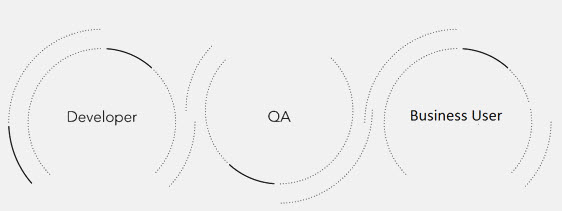Table of Content
3 Best Practices for Remote ERP Testing Based on Successful, Real-Life Projects
In light of the new business reality, organizations must continue to deliver their products and services with the highest quality without any setbacks. ERP reliability is a significant component of overall enterprise performance, and ERP Testing is the key to having just that. But a successful testing project requires a set of tools and methodologies that synchronize in perfect harmony.
Successful ERP testing projects also require business and IT organizations to be completely aligned. Challenges increase when employees across the globe need to collaborate with their peers remotely as if they were across the hall.
Battle Tested Principles for Remote UAT
Learn how to make your remote testing project a success with this distributed team’s Handbook.
Staying Focused and Ready to Deliver in Uncertain Times with Remote ERP Testing
By now, we all know the challenges of navigating an ongoing, global emergency. Priorities are shifting quickly, and directives become chaotic, while IT and business users are scrambling to catch up. How do you stay focused on a cross-organizational testing project to meet deadlines when working remotely?
What we Learned from our Test Dynamix Customers Working Remotely
Panaya’s ERP testing experts have come up with some best practices for executing a globally dispersed testing project. They are based on real-life success stories of multinational corporations. Here are the top 3 principles of remote testing efficiency and the projects that successfully implemented them.
1. Enabling Effective Tester Collaboration
A critical element to successful testing, is effective communication between all stakeholders. Testers have to know what to test, when to test, how, and with which data.
Developers have to know quickly that a defect is assigned to them; they need to effortlessly understand the root cause and steps to reproduce it, engage testers in discussion, etc.
Test managers need to share progress, and receive feedback from testers. They must be able to schedule reminders, communicate with project team members, and do more to get their project moving forward.
And while standard communication tools like Zoom and Skype are easy to use, they are not testing tools. Collaborative testing tools could provide you with automated handover between testers across the same business process such as:
- “Ready to Test” when it’s a user’s turn to test within the business process,
- “Retest” notification to testers upon defect resolution, and
- “Close” enforcement to testers upon retest success.
One more aspect of efficient testing is to have easy to use test evidence which can help you deliver granular information and save an enormous amount of time while improving collaboration between testers and between testers and developers. Having a collaborative tool enabling Self-generated test evidence at the click of a button reduces the back and forth between testers and provides a record of steps to reproduce opened defects.

Panaya Test Dynamix (TDx) supports collaborative communication between QA, developers, and business users for joint reviews and the detection of errors early in the testing cycle.
“We loved Panaya TDx for its collaboration features. It is a user friendly, cloud based solution that offers easily repeatable test scenarios between similar projects.” “We would recommend it to any other organization running SAP”
Pam Brown,
Senior Director, ERP Business Process Organization at Bruker
Read the full Bruker success story
2. Adopting a Holistic E2E View of the Entire Test Cycle
Test managers should always be able to see the full picture and take a holistic approach to navigating their ship through a sea of obstacles. When testing remotely, this is often easier said than done. But with the right tools in place, visibility and control can be effortless.
For example, having a holistic defect management approach can significantly reduce global test efforts. Being able to identify defects early in the test cycle and quickly relate them to any future or on-going tests, could save valuable time running tests that are bound to fail. Having a central defect management system can accelerate the entire execution process. Features like System-Wide Defect Management, block compromised tests and notify testers on potential issues. This,in turn minimizes idle time, improves testing efficiency, and removes a recurrent bottleneck of testing.
“Our key business users are focused on their daily activities. They are not technical testers. We trained them once on using Panaya and now there is less effort put into email communications around testing requests. The project manager schedules and monitors the workflow on a dashboard and the system notifies key users when it’s their turn to test. between similar projects. We would recommend it to any other organization running SAP.”
Phuong Vo Vinh
SAP Applications Project Manager at EFS
Read the full Etablissement Français du Sang (EFS) success story
3. Choosing the Right Tool
Too many companies are focusing more on the technical side of testing instead of on business process testing. This, in turn, creates a disconnect in the organization between IT and business users.
Specifically, for ERP testing, the focus has to shift towards business process testing and testing tools designed with non-technical users in mind.
In essence, this is not only critical for the success of your testing project, but it is also a great way to accelerate it. Equipping your teams with the right tools can make remote testing easy and effective. Choose a tool designed for business process testing, focus on a dedicated SaaS solution that is installation-free, easy to onboard and use, and business-user friendly, like Panaya Test Dynamix (TDx), and you’re on a sure path to success.

“We are using Panaya as a Testing Factory, so we are providing testing as a service to all our teams. This has proven to be especially effective with our offshore teams. The collaboration capabilities of Panaya helped us achieve our goals. We are now testing everything centrally – both on-site and offshore – with automated processes and test evidence. This ensures that our teams get very reliable feedback and can quickly and safely resolve and release.“
Sebastien Giraud,
Delivery & Test Manager at Lapeyre
Read the full Groupe Lapeyre S.A success story
Panaya Test Dynamix (TDx) customers have been running large-scale UAT projects remotely for years. They are able to use our technology to cut project cost and duration by 30% to 50%. They do it without traveling to the same location, or meeting for tens of hours in virtual rooms.
Are you currently testing remotely or have an upcoming remote testing project? ERP testing with Panaya Test Dynamix is now free for 14 days. Onboarding is quick and easy. Key features include business processes testing with automatic handover between users, as well as an intuitive real-time dashboard with actionable insights and automated defect management tools. Sign up now »
Battle Tested Principles for Remote UAT
Learn how to make your remote testing project a success with this distributed team’s Handbook.




